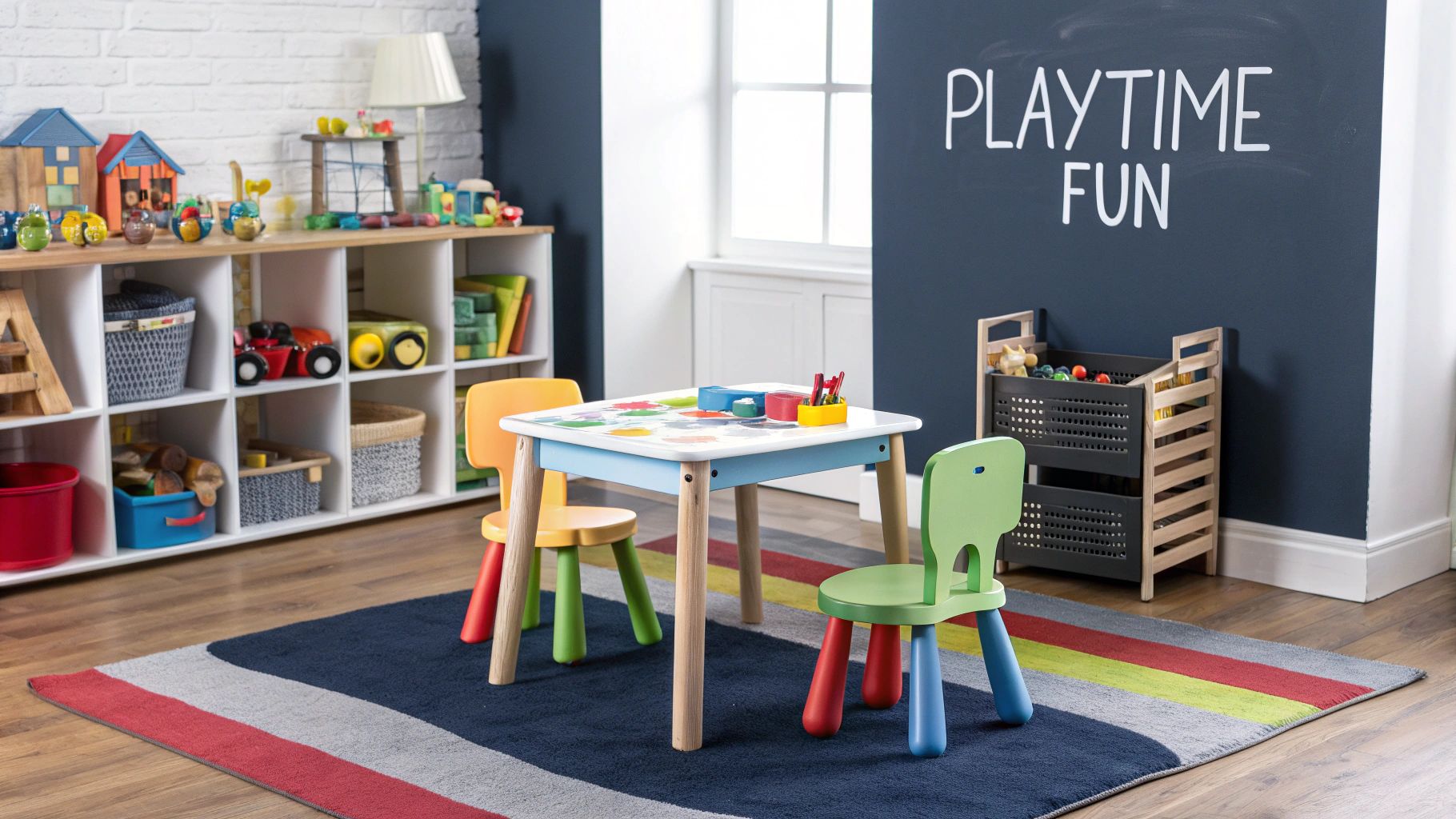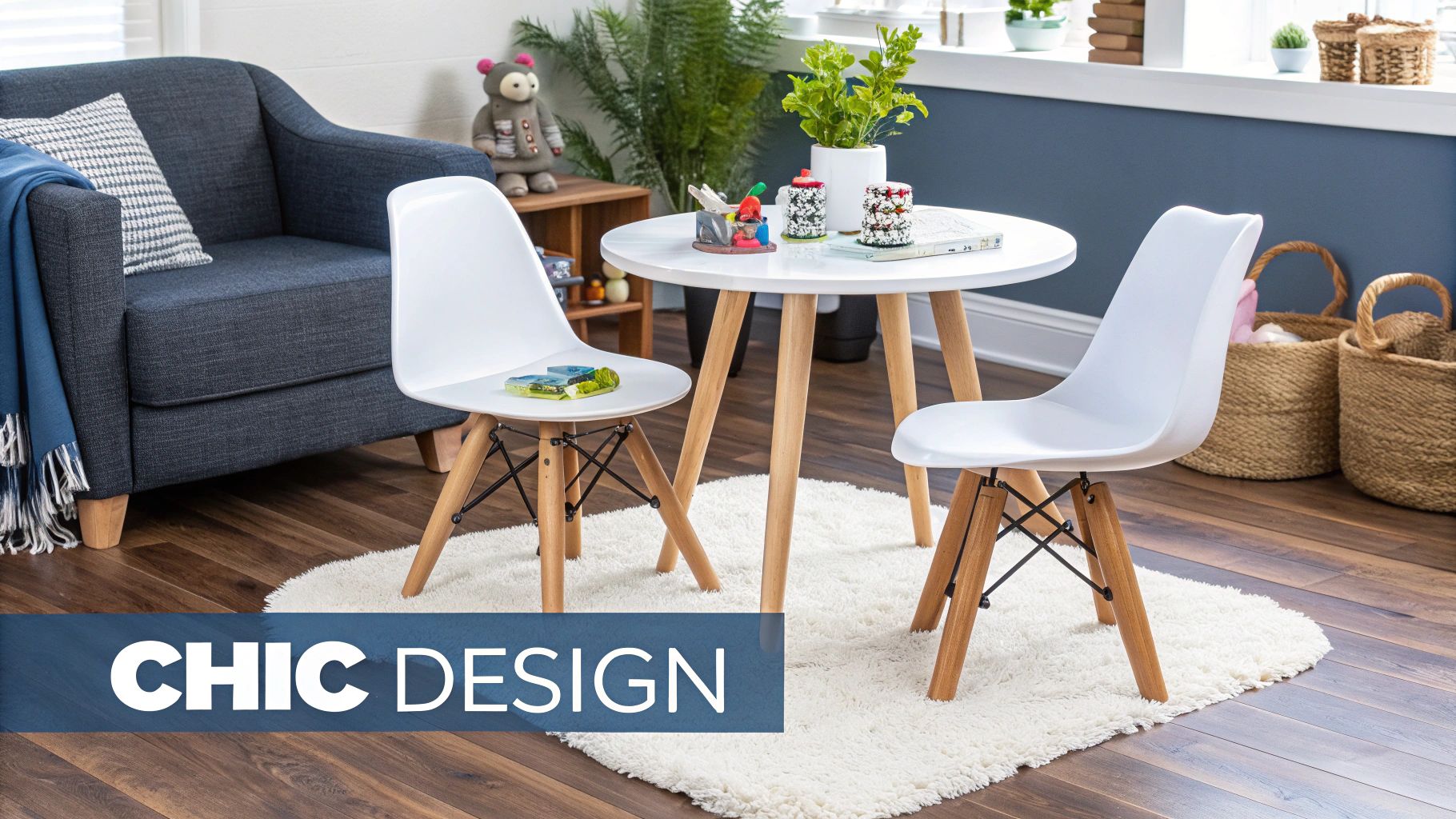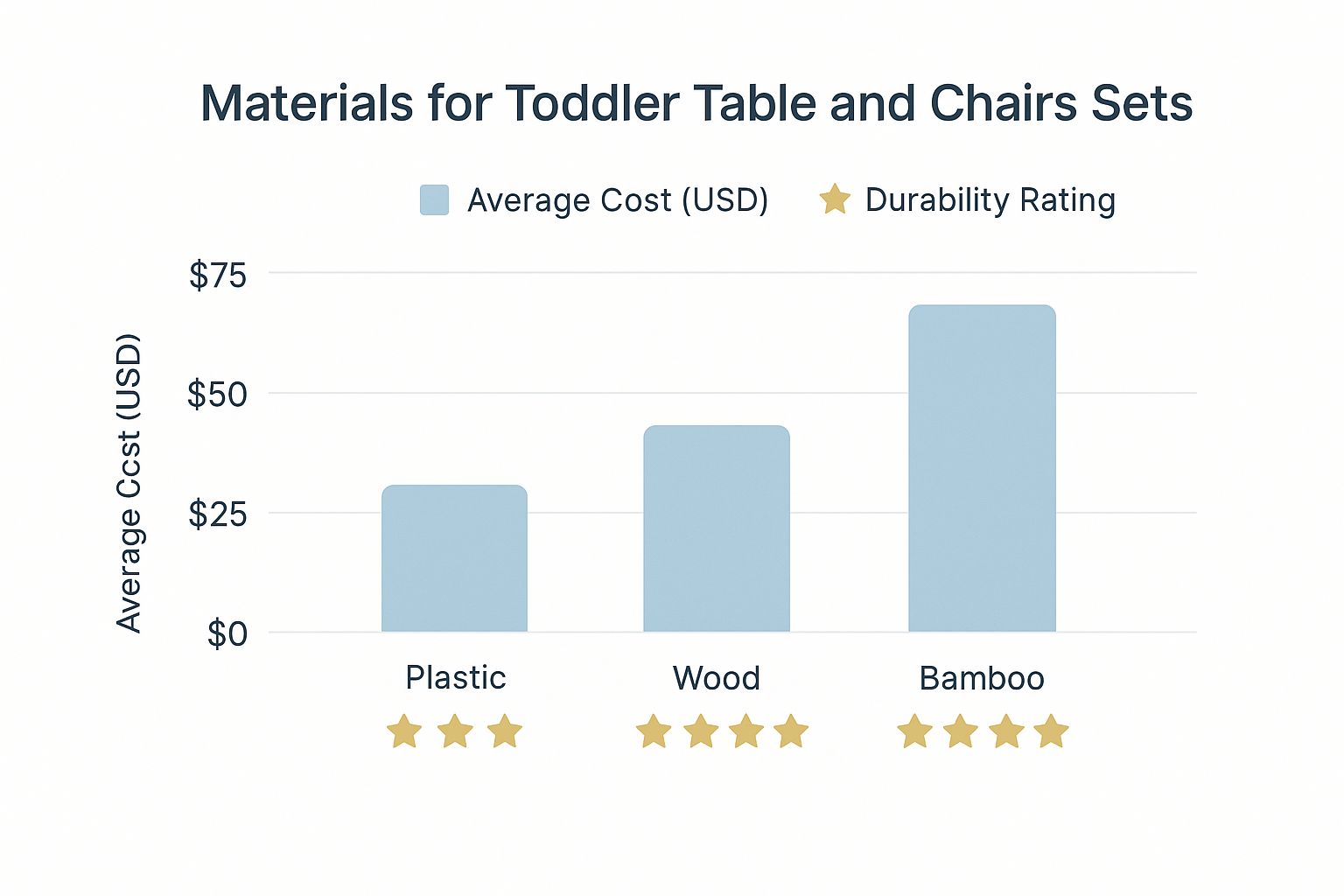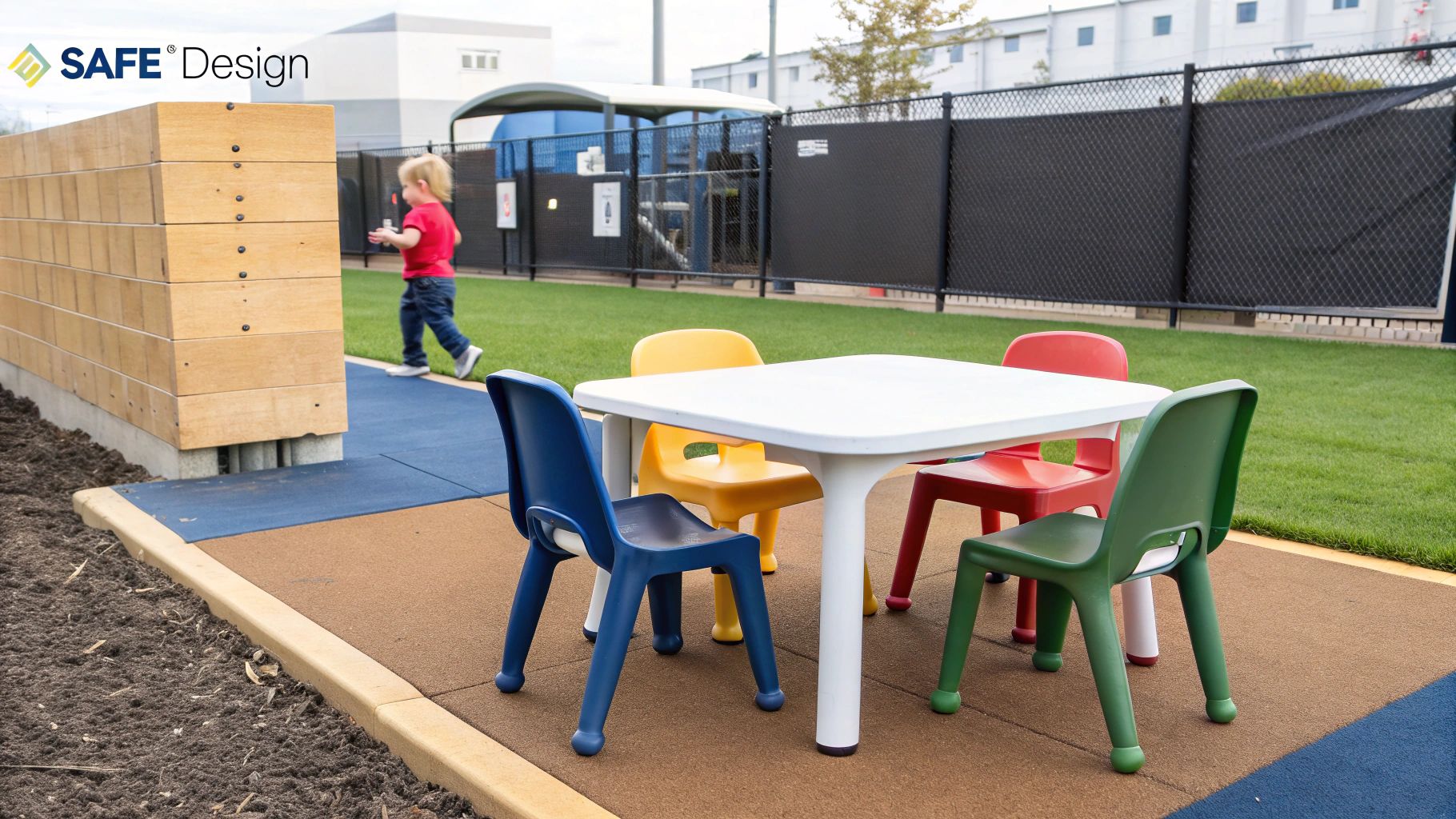
Choosing Your Toddlers Table and Chairs Set
Share
A toddlers table and chairs set is so much more than just miniature furniture. It's your child's first real spot for creativity, snacks, and play-based learning. This simple addition can completely transform a corner of your home into a hub for growth, supporting huge developmental milestones along the way.
Why Your Toddler Needs Their Own Creative Space

Think about it from an adult's perspective. We have a desk for work, a dining table for meals, and a comfy chair for relaxing. A toddlers table and chairs set gives a child that same sense of order and purpose, just perfectly scaled to their size.
It essentially creates an accessible "yes" space where they feel in control. When a toddler has a place that's all their own, it sends a powerful message: your activities are important. This sense of ownership encourages them to dive deeper into whatever they're doing, whether it's concentrating on a puzzle or carefully lining up their snacks.
Fostering Independence and Key Skills
A kid-sized table empowers your little one to be more self-sufficient. Instead of needing a boost to climb into a big dining chair, they can sit down and get up all on their own. That small act is a huge confidence-builder and a great way to practice physical coordination.
Beyond that, this dedicated spot is a developmental powerhouse. The activities they do here directly support crucial areas of growth:
- Fine Motor Skills: Gripping crayons, squishing play-doh, and placing puzzle pieces all happen at the perfect height, helping to refine hand-eye coordination.
- Postural Control: Sitting correctly in a chair that actually fits their body helps develop core strength and healthy posture—skills they'll need later in a classroom.
- Focus and Concentration: Having a specific area for activities helps minimize distractions, teaching them to focus on a single task for longer stretches of time.
A designated workspace for a toddler isn't a luxury; it's a tool for learning. It provides the structure they need to explore their creativity and practice the everyday skills that lead to greater independence.
A Hub for Daily Routines
You'll be amazed at how quickly this simple furniture set becomes central to your daily life. Imagine your toddler proudly serving "tea" to their stuffed animals or having a snack without needing to be strapped into a booster seat.
It becomes their go-to spot for messy art projects, quiet reading time, and everything in between. That versatility makes it one of the most-used items in any home with young children. For more ideas on setting up purposeful play areas, you can explore the benefits of a Montessori activity table in our guide. Ultimately, this one piece of furniture adapts to their ever-changing needs, making it a truly valuable investment.
Decoding Safety Features for Toddler Furniture

When you're picking out a toddlers table and chairs set, it's easy to get caught up in how it looks. But let's be real—safety is the absolute foundation. Before you even think about color or style, making sure the furniture is genuinely safe for your little one has to be priority number one. This means looking past the cute designs and really understanding what makes a piece of furniture safe versus what just looks good.
The first thing I always check is the corners and edges. Sharp, 90-degree angles are just asking for trouble with a wobbly toddler who’s still getting the hang of walking. Look for sets where every single edge is smoothly rounded or beveled. Trust me, this small detail can be the difference between a major ouch and a minor bump.
Next up is stability. It's a non-negotiable. Toddlers are climbers, leaners, and professional furniture-pushers. A good table needs a wide, sturdy base that won’t tip over when they inevitably try to scale it. For the chairs, I look for legs that splay outwards. This creates a bigger footprint and makes them much harder to topple, even with a serious case of the wiggles.
Understanding Non-Toxic Materials and Finishes
What the furniture is made of is just as important as how it's built. More and more parents are looking for pieces with non-toxic, low-VOC (Volatile Organic Compound) finishes, and for good reason. VOCs are chemicals from paints and glues that can get into the air and mess with your home's air quality.
Prioritizing a set with a low-VOC or zero-VOC finish is a direct investment in your home's air quality and your child's long-term health. It ensures their creative space is a healthy space.
To cut through the marketing noise, keep an eye out for official safety certifications. They're like a stamp of approval from a third party, giving you real confidence in your purchase.
- JPMA Certification: The Juvenile Products Manufacturers Association gives this to products that meet high standards for safety and performance.
- GREENGUARD Gold Certification: This is one of the toughest certifications to get. It means a product has super low chemical emissions, which is great for healthier indoor air.
These labels help you find a genuinely safe toddlers table and chairs set without having to just take a company's word for it.
Spotting Hidden Dangers in Designs
Beyond the obvious stuff, some design flaws can be tricky to spot. Take a close look at the set for any weird gaps, holes, or openings. You want to make sure there's nowhere for tiny fingers, arms, or even a curious head to get stuck. This is a big one for chairs that have decorative cutouts or slats on the back.
Another thing that often gets missed is the weight of the chairs. Those super lightweight plastic chairs are a breeze to move and clean, but they can be a hazard for new walkers. If a chair is too light, it can slide right out from under a toddler as they try to sit. A chair with a little more heft gives them the stability they need to sit down safely all by themselves.
The good news is that the industry is paying attention. The global market for kids' table and chair sets hit about $2.1 billion in 2024 and is expected to keep growing as more parents demand safer, better-designed products. You can even check out the full kids' furniture market analysis to see how this trend is pushing innovation. When you choose a set that’s been thoughtfully designed, you can finally relax, knowing their little corner of the world is a secure spot for all their big ideas.
Picking Materials That Can Survive Toddlerhood
From spilled juice to rogue crayon marks, a toddler's table and chairs have to be tough. The material you pick for a toddlers table and chairs set really dictates how well it handles the daily creative chaos, how simple it is to clean, and ultimately, how long it will last.
Think about your daily life for a second. Is your little one a budding Picasso who loves messy paints and sticky glue? Or is the table mostly a snack station, destined to face an endless barrage of crumbs and spills? Knowing this will point you toward the perfect material for your family.
The Classic Durability of Wood
Solid wood tables are pretty much the gold standard for longevity. Materials like oak, maple, or birch are incredibly durable. They can often be sanded and refinished if they get scratched or stained over time, which is a huge plus. This makes a good wooden set a fantastic long-term investment that can grow with your child and maybe even get passed down.
But here's the thing: not all wood is created equal. Softer woods like pine can dent easily if a toy gets dropped on them with any force. For a wood set to be truly kid-proof, it needs a solid, protective sealant. A lacquered or sealed finish makes wiping away messes a breeze and stops liquids from soaking in and causing damage.
This image gives a quick comparison of popular materials based on what you'll likely spend versus how durable they are.

As you can see, while wood and bamboo come out on top for durability, plastic is a much more budget-friendly option for many parents.
The Practicality of Plastic and MDF
For parents who are all about easy cleanup and fun, vibrant colors, high-quality plastic is a fantastic choice. These sets are lightweight, usually designed with safely rounded edges, and can be wiped clean in seconds. This makes them absolutely ideal for a dedicated arts and crafts corner where paint, glitter, and play-doh are regular guests.
Medium-Density Fiberboard (MDF) is another common material you'll see, especially in more budget-friendly sets. It provides a smooth, stable surface that's perfect for puzzles and building blocks. The main catch with MDF is its vulnerability to water damage. If the top layer chips or peels, any spilled liquid can seep in and cause the material underneath to swell and warp.
Material Showdown for Toddler Table Sets
Choosing between wood, plastic, or MDF can feel tricky. Each has its place depending on your budget, style, and how you plan to use it. This table breaks down the essentials to help you make a smart choice.
| Material | Pros | Cons | Best For |
|---|---|---|---|
| Solid Wood | Extremely durable, long-lasting, can be refinished, timeless look. | Can be expensive, heavier, softer woods can dent. | A long-term investment piece that can handle years of use and be passed down. |
| Plastic | Lightweight, easy to clean, affordable, available in bright colors. | Can feel less sturdy, may fade in the sun, can look "cheaper." | Messy arts and crafts, outdoor use, or families wanting a fun, low-maintenance option. |
| MDF | Budget-friendly, smooth surface, lightweight. | Susceptible to water damage, can't be easily repaired if chipped. | Light indoor activities like puzzles and coloring, or as a cost-effective starter set. |
At the end of the day, the right material comes down to what you need it for. By matching the material to your child's activities and your family's lifestyle, you’ll find a set that not only survives toddlerhood but becomes a cherished spot for play and discovery.
Finding the Perfect Fit for Your Child and Space

Getting the size right for a toddlers table and chairs set is more than just pulling out a tape measure. It's about creating an inviting little world for your child and encouraging good posture from the start. A set that’s too big or too small can be a real source of frustration for a toddler, making it tough for them to get comfortable and focus on their masterpiece or snack. The goal is to find a set that feels like it was made just for them.
The golden rule of ergonomics is surprisingly simple: when your toddler sits down, their feet should rest flat on the floor. Their knees should naturally form a comfy 90-degree angle. This "90-90-90" posture is the sweet spot for supportive seating. It gives them stability and stops their little legs from dangling uncomfortably in mid-air.
So, before you even start browsing, grab a measuring tape and measure the distance from the floor to the back of your child's knee. That number is the ideal seat height you should be looking for. A chair that’s too high or too low can put a strain on their back and make it hard to sit still.
Measuring for Table Height and Space
Once you’ve figured out the perfect chair height, the rest is easy. A good rule of thumb is to look for a tabletop that is about 8 inches higher than the chair’s seat. This gives them plenty of room for their legs underneath while keeping the surface at a natural height for drawing, eating, or playing without having to hunch over.
Here’s a quick way to check: have your child sit at the table and rest their arms on top. Their elbows should be bent at roughly a 90-degree angle. This simple ergonomic trick helps reduce strain on their neck and shoulders, making those long coloring sessions much more comfortable.
An ergonomically correct table and chair set isn't just about comfort—it's about empowering your child. When their furniture fits them properly, they can sit and stand independently, which builds confidence and supports their physical development.
Now, let's talk about your space. Not everyone has a sprawling, dedicated playroom, and that’s totally okay. A well-chosen toddlers table and chairs set can fit beautifully into a living room corner or a little nook in the kitchen.
Before you click "buy," I highly recommend using painter's tape to mark out the dimensions of the set on your floor. Don’t forget to leave enough room to pull the chairs out! This little trick gives you a real-world feel for how much space it will take up, ensuring it becomes a seamless part of your home instead of a clunky obstacle course.
If you’re drawn to a philosophy that prioritizes child-led learning and perfectly scaled furniture, you might find our guide on the Montessori table and chair really interesting. Finding the right fit is a huge step in creating an environment where your toddler can truly flourish.
Assembly and Maintenance Without the Headaches
That flat-pack box holding your new toddlers table and chairs set doesn't have to be a source of dread. Trust me, with a little prep, you can make the whole process smooth and maybe even a little fun.
Before you even think about touching a screw, my best advice is to open the box, lay every single piece out, and sort the hardware. I use small bowls or even a muffin tin. This one simple step saves you from that frantic search for that one specific bolt midway through the build.
As you start putting it together, resist the urge to tighten everything down immediately. Keep the screws just a little loose until all the pieces are connected. This gives you some much-needed wiggle room to get everything perfectly aligned—super important for making sure the table and chairs are level and don't wobble. Once it's all together, then go back and tighten everything up.
Keeping Your Set in Top Shape
Okay, so the set is built. Your work isn't quite done. A little ongoing care will keep it safe and looking great through years of creative chaos. Think of it less as a chore and more as transforming a simple purchase into a lasting part of your child’s room.
This is a big deal, especially when you look at what other parents are saying. Durability is a huge concern. While a set might look great online, customer feedback often highlights assembly headaches and long-term sturdiness as major issues. In fact, 18.4% of negative reviews point directly to assembly challenges. A well-maintained set is your best defense against these common problems.
To stay ahead of the wear and tear, just create a super simple maintenance checklist:
- Monthly Bolt Check: Toddlers are masters of wiggling. At the start of each month, give all the screws and bolts a quick check and tighten any that have come loose.
- Surface Inspection: Run your hand over the wood or plastic surfaces. You're feeling for any splinters, sharp edges, or peeling finishes that could snag little hands or clothes.
- Wobble Test: Give the table and each chair a firm shake. You want to make sure they're still stable and not at risk of tipping over.
A proactive approach is everything when it comes to safety. Taking just five minutes a month to check the hardware can stop a wobbly chair from becoming a real hazard.
Smart Cleaning for Every Mess
Different materials need different cleaning strategies. For plastic sets, a simple wipe-down with a damp cloth and some mild soap will handle most of the daily grime. If you're dealing with stubborn crayon or marker, a magic eraser usually works wonders without needing harsh chemicals.
Wood surfaces, on the other hand, need a gentler touch. You want to avoid soaking them with water, as it can warp the wood and ruin the finish. Instead, use a lightly dampened cloth and dry it off right away. For a deeper clean that preserves the finish, look for a cleaner made specifically for wood.
This approach keeps your toddlers table and chairs set looking new and ready for the next snack or art project. And for tips on managing the inevitable post-playtime explosion, check out our guide on finding the perfect toys storage organizers.
A Few Common Questions About Toddler Tables
So, you've picked out the perfect little table and chair set. But now that it's in your home, you might have a few questions popping up. Don't worry, that's completely normal. Think of this as your quick guide to navigating this new piece of furniture.
From figuring out the right time to introduce it to knowing when your little one has finally outgrown it, we’ve got you covered.
What Is the Best Age to Introduce a Table and Chairs Set?
This is probably the number one question parents ask. While there isn't a single magic number, most kids are ready for their own table between 18 and 24 months old.
The real tell isn't their age, though—it's their physical stability. Can they walk confidently? Can they sit down and stand back up without your help? If so, they likely have the core strength and coordination to use the furniture safely. Introducing it now empowers them to use their own little space without getting frustrated.
It’s best to wait until they're steady on their feet. If they're still a bit wobbly, they might try to use the lightweight chairs for support, which could easily cause a slip or a tumble.
How Can I Encourage My Toddler to Use Their New Table?
Sometimes, a new piece of furniture can be met with... well, a bit of suspicion. The best way to get your toddler on board is to make their new table the most exciting spot in the room. Don't just tuck it away in a corner; make it a central hub for fun right away.
Here are a few simple ideas that work wonders:
- Make it Snack Central: Start serving their favorite snacks and drinks only at their new table. This creates an immediate, positive connection.
- Designate "Table-Only" Toys: Keep a few special items—like a new puzzle, some fresh play-doh, or a specific coloring book—that can only be used at the table.
- Join Them on Their Level: Your presence is a huge draw. Pull up a cushion and sit on the floor next to them while they create or play. It makes the space feel special and important.
The goal is to make the table a destination, not just another piece of furniture. By consistently linking it to their favorite activities—eating, creating, and playing—it will naturally become their go-to spot for focused fun.
When Has My Child Outgrown Their Toddler Set?
You'll start to see some obvious physical signs when it's time to size up. If their knees are bumping the underside of the table or their feet aren't flat on the floor anymore when they're sitting, it's a clear signal.
Pay attention to their posture. Are they hunching their shoulders to draw? Are their elbows bent at a weird angle? If so, the set is no longer a good ergonomic fit. This is when it's time to start looking for a larger, kid-sized desk or table that can better support their growing body for things like homework and bigger art projects.
Ready to create that perfect little corner for your budding artist? Explore the thoughtfully designed and safety-focused children's furniture from Ocodile. Find the ideal set to support your child's independence and imagination. Discover our collection today at ocodile.com.








